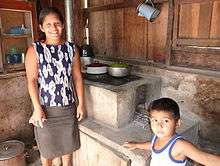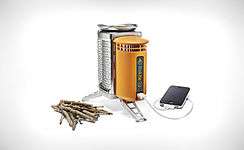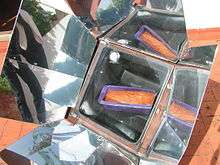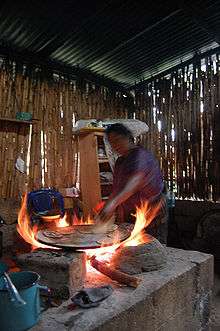Cook stove

A biomass cook stove is heated by burning wood, charcoal, animal dung or crop residue. Cook stoves are commonly used for cooking and heating food in developing countries.
Households in developing countries consume significantly less energy than those in developed countries; however, over 50% of the energy is for cooking food. The average rural family spends 20% or more of its income purchasing wood or charcoal for cooking . The urban poor also frequently spend a significant portion of their income on the purchase of wood or charcoal.
Cooking over a traditional open fire or mud stove can cause increased health problems brought on from the smoke, particularly lung and eye ailments, but also birth defects. The health problems associated with cooking using biomass in traditional stoves affect women and children most strongly, as they spend the most time near the domestic hearth.[1] Replacing the traditional 3-rock cook stove or mud stove with an improved one and venting the smoke out of the house through a chimney can significantly improve a family’s health.
Deforestation and erosion often result from harvesting wood for cooking fuel. The main goal of most improved cooking stoves is to reduce the pressure placed on local forests by reducing the amount of wood the stoves consume, and to reduce the negative health impacts associated with exposure to toxic smoke from traditional stoves.
Three-stone cooking fire
The traditional method of cooking is on a three-stone cooking fire or on a mud stove. The three-stone fire is the cheapest stove to produce, requiring only three suitable stones of the same height on which a cooking pot can be balanced over a fire. However, this cooking method also has problems:
- Smoke is vented into the home, instead of outdoors, causing health problems. According to the World Health Organization, "4.3 million people a year die prematurely from illness attributable to the household air pollution caused by the inefficient use of solid fuels (2012 data)."[2]
- Fuel is wasted, as heat is allowed to escape into the open air. This requires the user to gather more fuel and may result in increased deforestation if wood is used for fuel.
- Only one cooking pot can be used at a time.
- The use of an open fire creates a risk of burns and scalds.[3] Particularly when the stove is used indoors, cramped conditions make adults and particularly children susceptible to falling or stepping into the fire and receiving burns. Additionally, accidental spills of boiling water may result in scalding, and blowing on the fire to supply oxygen may discharge burning embers and cause eye injuries.
Improved stoves and other measures
The World Health Organization has documented the significant number of deaths caused by smoke from home fires.[4] The negative impacts can be reduced by using improved cook stoves, improved fuels (e.g. biogas, or kerosene instead of dung), changes to the environment (e.g. use of a chimney), and changes to user behavior (e.g. drying fuel wood before use, using a lid during cooking)."[2] Improved stoves are more efficient, meaning that the stove's users spend less time gathering wood or other fuels, suffer less emphysema and other lung diseases prevalent in smoke-filled homes, while reducing deforestation and air pollution. However, a closed stove may result in production of more soot and ultra-fine particles than an open fire would.[5]
For instance, an improvement of the energy efficiency from 25% for the traditional Lao stove (wood and charcoal fired) to 29% efficiency for an improved Lao stove, results in 21% less wood fuel being needed, and saves 182,000 ton CO2eq emissions, as reported in a GHG-compensation project.[6] The traditional Lao stove needs an average of 385 kilograms of charcoal and 450 kilograms of wood per year as fuel. For making a kilogram of charcoal about seven kilograms of wood is needed. The report also indicates that in Cambodia 369,000 tons of non-renewable biomass wood fuel is consumed yearly for charcoal production for these stoves, destroying 45 km² of deciduous forests. 4% of the forest regrows.
Some designs also make the stove safer, preventing burns that often occur when children stumble into open fires. Some of the new stove designs are as follows:
Brick and mortar stove
A variety of new brick and mortar stoves have emerged. Most of the new designs incorporate a combustion chamber found in a Rocket stove. By confining combustion to an insulated and enclosed area, the stoves increase the core temperature and thereby achieve more complete combustion. This allows a smaller amount of fuel to burn hotter, while producing less ash and smoke.[7] The Justa Stove is a simple biomass stove built around an insulated, elbow-shaped combustion chamber which provides more intense heat and cleaner combustion than an open fire, meaning that it consumes less fuel than a three-stone stove.

An improved Justa Stove jointly developed by the non-profit Proyecto Mirador and the Aprovecho Research Center called the "Dos por Tres" is being disseminated in Honduras with more than 20,000 stoves installed as of 2011. The Dos por Tres has been registered as Project 690 and certified by the Gold Standard Foundation to reduce greenhouse gas emissions by 2.7 tons per year. All Proyecto Mirador documentation related to proof of these reductions can be viewed on the Gold Standard Project registry.[8]
The Justa Stove[9] has been deployed in Honduras by Trees, Water & People and ADESHA, for which they jointly won an Ashden Award in 2005.[10] The Eco Stove and the Patsari stove share common benefits with the Justa Stove, and are also used in Central America. Their proponents claim that these stoves use approximately 1/3 of the fuel required by traditional three stone stoves, lessening the daily labor devoted to gathering wood and also preventing deforestation. At the same time, it employs a stove pipe flue to vent fumes through the roof.[11] This almost eliminates cooking smoke within the home, preventing respiratory problems for the users. Various groups have run programs to provide such stoves, or encourage production of stove making facilities, including certain Rotary Clubs; Trees, Water and People;[12] and organizations aimed at preserving wildlife by preventing deforestation.
Lorena adobe stove
A predecessor to the Justa/Eco/Patsari Stoves was the Lorena adobe Stove. It was designed as a simple-to-build cook stove for use in Central America, that could be manufactured locally of materials. The name of Lorena Stove comes from the combination of the two Spanish words lodo and arena (meaning mud and sand) as the stoves were a combination of the two. The Lorena Stove is an enclosed stove of rammed earth construction, with a chimney built onto it.[13]
The Lorena Stove was designed with the mistaken belief that rammed earth would act as insulation; there was a basic misunderstanding of the difference between mass and insulation. Good insulation resists the passage of heat; thermal mass does the opposite, it absorbs heat. Testing has shown that the rammed earth used in the Lorena stove absorbs heat that should be directed toward cooking.
However, this "waste" heat radiates into the structure, providing more efficient heating than an open fire (a disadvantage in hot weather). A Lorena stove can also be used to dry clothes as its mass slowly cools off after the fire dies.
The designers, Aprovecho, now state: "The Lorena has been tested over the years by many researchers and has generally been found to use more firewood than an indoor open fire. The stove has other attributes. Its chimney takes smoke out of the kitchen and it is well liked. It is pretty and a nice addition to the house. It is low cost and can be repaired and even built by the home owner. But, it is not a fuel saving or low emission stove". In later designs, the rammed earth has been replaced with thermal insulation, such as pumice or ash.
Kenya Ceramic Jiko
From the beginning of the appropriate technology movement, one of the principal goals has been to create an affordable stove that was more efficient than the universally used three stone cooking fire. The Kenya Ceramic Jiko is one of the improved stoves.
Charcoal is the standard cooking fuel in East Africa. Traditionally it was burned in a metal stove or “Jiko” as stoves are called in the Swahili language. The KCJ is the traditional Jiko with a ceramic liner. The initial model has a distinctive shape, differing from the traditional cylindrical jiko, with the top and bottom the same diameter, tapering at about 30 degrees to a waist.
Sanjha Chulha/Earth Stove/Surya Stove
Since 1999, an engineering company named Nishant Bioenergy (P) Limited in North India is conceiving, designing, fabricating and selling patent pending biomass briquette and pellet fueled cook stoves. These are useful for commercial cooking and are designed to burn biomass pellet and briquette. Biomass briquettes can be made from any farm or forest residues with or without binders and pellets are made with or without the addition of binder.
The company has won national and international recognition for their efforts, including the Ashden Award in 2005,[14] PCRA Award-2001, and UN promising practices-2006.
Nishant Bioenergy developed its first stove in 1999 and named Sanjha Chulha (community-cooking stove) is an "Institutional Cook Stove" for use with multiple cooking pot and hot water tank as combined cooking. The stove name is derived from a village tradition where women would cook all their chappatis / rotis (Indian bread) on a "Sanjha Chulha", which was a communal earthen cook stove used by everyone. The stove was designed by Ramesh K. Nibhoria who also designed the Earth Stove for cooking and frying use with a single pot. Earth Stove has two model, one is fixed pellet feed and second one with automated pellet feeding system. Earth Stove with automated pellet feeding system is very innovative and has controls on heat intensity from zero to full like LPG. New design is applied for patents and also being registered under copy write acts.
The Surya Stove by Nishant Bioenergy runs on powdered biomass such as saw dust or any other biomass that has a moisture content level of 15% . The stove has an automated fuel feed system (duly linked with temperature controller) and ash cleansing system. It has a temperature controller to pre-set the temperature of the cooking/frying medium. It is especially designed for the frying needs of the ready-to-eat food industry as well as for controlled hot air requirement.
Project Surya
Project Surya, by Scripps Institute of Oceanography at UCSD, field tested improved cook stoves and modifications during its pilot phase which is now complete and the results have been posted online.[15] Project Surya has also launched the Carbon Credit Pilot Project (C2P2) to explore if rewarding women directly with funds from carbon markets, for using improved stoves, will significantly enhance adoption of the field tested stoves.
Prefab stoves
The Ecocina stove was designed by StoveTeam International and is manufactured at a central location from cement, pumice, and ceramic tiles. It resembles a large flower pot, with a steel cooking surface which can also receive a pot.[16] It was created by a volunteer worker who noticed the high number of respiratory illnesses and burns on patients in Guatemala. It is actively produced in countries such as Guatemala, El Salvador, Honduras, Nicaragua and Mexico. Unlike its brick and mortar counterparts, the Ecocina stoves have no flue and are manufactured in a backyard factory. They are then placed in a home on top of a table or similar raised surface. As with its brick and mortar counterpart, the Ecocina stove employs a rocket stove combustion chamber and promises reduction in the consumption of firewood and in the amount of fumes emitted into the home. It also remains cool to the touch, preventing burns.
Baker stoves
The Baker cook stove was developed by Top Third Ventures and designed by Claesson Koivisto Rune. It is designed to emphasize aesthetic appeal, usability, and cultural conformity. Rural households in Kenya are its target consumer group. The Baker cook stove is made up of metal components. Thermal insulation and a forced air flow mechanism result in a higher combustion temperature and safer and cleaner cooking compared to the traditional three-stone cooking fire.[17]
Turbo stoves
Some new metal stoves employ turbo-charging features such that air pressed into the stove or swirled, will then significantly increase the efficiency of combustion.
The Lucia Stove developed by World Stove employs swirling air patterns to change combustion and has been economically produced. It is marketed by World Stove as one part of a larger environmental solution because it captures carbon and thereby reduces the amount of carbon in the atmosphere from cooking. It produces Biocarb that is then recycled back to the soil.[18]
The Turbococina Stove was developed in El Salvador by René M. N. Suarez;[19] the name is derived from the term “Turbocombustión” which is a new combustion method in which, during combustion, temperatures as low as possible are maintained to inhibit the formation of pollutants like NOx; an alternative is to reduce the concentration of oxygen below the stoichiometric requirement. The Turbococina promised positive results by employing higher pressures to lower combustion temperatures, but its high cost of production (stainless steel) and its use of electricity have prevented it from going into production. At present, it does not appear to be economically viable.
BioLite Stoves

The BioLite HomeStove was made to replace open cooking fires. Its design converts the heat into usable electricity to power a fan, which reduces fuel needs by 50%, toxic smoke by about 95%, and black carbon emissions by 91%. The amount of CO2 saved per year by one stove is equivalent to the amount saved by buying a hybrid car.[20] The effects of deforestation are lessened and time is regained by people spending less hours gathering wood for open fires. The remaining off-grid energy that does not power the fan can then be used to charge portable devices through a USB port, such as cell phones and LED lights.[21][22]
Solar stoves

Simple solar stoves use the following basic principles:
- Concentrating sunlight: A reflective mirror of polished glass, metal or metallised film concentrates light and heat from the sun on a small cooking area, making the energy more concentrated and increasing its heating power.
- Converting light to heat: A black or low reflectivity surface on a food container or the inside of a solar cooker improves the effectiveness of turning light into heat. Light absorption converts the sun's visible light into heat, substantially improving the effectiveness of the cooker.
- Trapping heat: Convection can be reduced by isolating the air inside the cooker from the air outside the cooker. A plastic bag or tightly sealed glass cover traps the hot air inside. This makes it possible to reach temperatures on cold and windy days similar to those possible on hot days.
Bio ethanol Fueled Cook Stoves
Clean energy bio-ethanol cooking fuel in Kenya has been pioneered by International Research & Development Africa Ltd with a BIOMOTO Cook stove. Bio-ethanol fuel is manufactured from food crop stover and post harvest, contaminated and damaged starch crops purchased from bottom of pyramid farmers.
Another initiative is Project Gaia. Alcohol fuels, such as ethanol, burn quickly, cleanly and are renewable. Project Gaia works with the CleanCook, a clean-burning stove that use absorption technology to burn the ethanol.
Improved Cook Stoves
Improved Cook Stoves (ICS) are designed to reduce the fuel consumption per meal and to curb smoke emissions from open fires inside dwellings. They are designed for developing country settings as a low cost bridging technology.
There are various designs, such as the ONIL Stove which uses mortar-less concrete blocks in its construction. Another design is the Berkeley-Darfur stove that reduces smoke and is twice as efficient as a clay stove, with the goal of reducing the need for women to leave the camps in search of wood.[24]
The Save80[25] is a portable stove with an integral 8-liter pot (both made of stainless steel) and weighs about 4 kg. It has a nominal effective thermal power of 1.5 kW and needs 250 g of small dry wood sticks to bring 6 liters of water to the boil, which is 80% less than a traditional cooking fire. This efficiency is achieved using the 8-liter pot that is design-optimized for this stove. On one side near the upper rim there is a small port for feeding additional fuel into the already burning stove. The stove design ensures pre-heating of the air supply from the bottom inlet and complete combustion with no visible smoke and relatively small amounts of ash. Exhaust air outlets are on the side opposite the fuel feed port.
The Save80-Wonderbox is made of expanded polypropylene, which is specifically designed to contain the 8-liter pot of the Save80 stove. It is designed to keep a near boiling temperature for a relatively long time. After reaching the boiling temperature, food – for instance rice – can be transferred to the Wonderbox, a retained heat cooking device. There it continues to heat up.
The solar cooker uses no fuels. These devices require clear sunlight, and are practical in many of the sunny regions of the world.[26]
The Energy and Resources Institute cookstove model SPT-610 has an efficiency of 37%[27] and has been developed in collaboration with Indian Institute of Technology Delhi.
Advanced biomass cookstoves
There are two primary types of advanced biomass stoves[28] that can achieve high levels of performance; forced air stoves and gasifier stoves, both of which can run on processed or raw biomass.
- Forced air stoves have a fan powered either by a battery, an external source of electricity, or a thermoelectric generator. This fan blows high velocity, low volume jets of air into the combustion chamber, which when optimized results in more complete combustion of the fuel.
- Gasifier stoves force the gases and smoke that result from incomplete combustion of fuels such as biomass back into the cookstove's flame, where the heat of the flame then continues to combust the particles in the smoke until almost complete combustion has occurred, reducing emissions. Typical gasifier stoves are known as Top Lit Updraft (TLUD) stoves because some fuel is lit on top of the stove, forcing combustible products to pass through the flame front before being emitted into the air.
Classification of cook stoves
Classification of cook stoves[29][30]
- 1. Three-stone fire
- 2. Early “ICS” “Improved Cook Stoves” to 1990s (clay/ceramic/buckets)
- 3. Fuel-controlled stoves (mainly Rocket stoves)
- a. Simple (portable) b. Stationary (w/ chimney) c. Forced-air (FA)
- 4. Semi-gasifiers (mainly China and Vesto) w/ some air control
- 5. Gasifiers (“micro-” for cooking), some with FA (Fan Assistance)
- a. Top-lit updraft (known as TLUDs) w/ migrating pyrolytic zone (batch)
- b. Updrafts and downdrafts w/ stationary gasification zones (continuous)
- c. Other drafts, including cross and opposite/opposing drafts
- 6. “Fan-jet” with very strong air currents into the fuel (3 known examples):
- a. Philips-FA
- b. Lucia-FA
- c. Turbococina
- 7. Non-biomass. Stoves not using raw dry biomass fuels:
- Charcoal; alcohol; refined fossils; coal; biogas; electric; solar.
Multi-mode capable stoves can be used only in one way at any one time.
See also
References
- ↑ "Household air pollution and health". World Health Organization.
- 1 2 Indoor air pollution and health - World Health Organization fact sheet.
- ↑ "Health Benefits". The ONIL Stove. Retrieved 2007-04-13.
- ↑ Indoor air risks; World Health Organization
- ↑ Umair Irfan (April 5, 2013). "Study finds improved cookstoves solve one emissions problem, but create another". ClimateWire E & E Publishing. Retrieved April 5, 2013.
- ↑ Fuel wood saving with improved cookstoves in Cambodia
- ↑ Design Principles for Wood Burning Cookstoves
- ↑
- ↑ YouTube Video on Justa Stove
- ↑ Justa stove wins Ashden Award
- ↑ Diagrams and Plans for Justa Stove
- ↑ Trees, Water and People
- ↑ Household stoves construction manual; bioenergylists.org
- ↑ Ashden Award for Nishant Bioenergy
- ↑ Aprovecho Research Center Test-Results-Cookstove-Performance.pdf
- ↑ YouTube Video on Ecocina Stove
- ↑ http://www.fastcoexist.com/1681925/a-simple-elegant-stove-to-make-cooking-safer-in-africa
- ↑ YouTube Video on Lucia Stove
- ↑ René M. N. Suarez, US Patent 6651645
- ↑ "BioLite Home Stove". Design To Improve Life.
- ↑ "MICROGRID ENERGY RULES THE SUSTAINABLE BRANDS INNOVATION OPEN". Fast Company. 11 June 2010.
- ↑ "OWPG Derryck Draper Award goes to BioLite Campstove". OWPG. 18 October 2012.
- ↑ Solar Cooking Atlas Website about solar stoves and solar cookers
- ↑ "What is a Darfur Stove - Darfur Stoves Project". Retrieved 2008-07-14.
- ↑ Highly efficient stove: Save80
- ↑ "Solar Household Energy". Retrieved 2011-07-27.
- ↑ http://www.worldstainless.org/Files/ISSF/non-image-files/PDF/Protection_of_the_Environment/About_TERI_model_Stove.pdf
- ↑ The Global Alliance For Clean Cookstoves - Cookstove technology
- ↑ Paul S. Anderson
- ↑ Paul S. Anderson, 2011.Classification.pdf
External links
- Improved stoves at Appropedia, an anti-poverty and appropriate technology wiki.
- Partnership for Clean Indoor Air
- StoveTeam International
- Aprovecho stove research
- Rethinking the Latin American Cookstove by Dean Still. A critical assessment of Lorena stoves & other new "improvements", and a discussion of how to improve the design.
- Final Report for "Lorena Stoves to Protect Lungs and Forests" - The Virtual Foundation
- Burning Issues - A project of Clean Air Revival, Inc.. Promotes awareness of the negative health impacts of wood smoke.
- BioEnergy Lists: Biomass Cooking Stoves
- Holey Briquette Gassifier Stove Development - Richard Stanley, Kobus Venter 14 August 2003, on BioEnergy Lists
- Asia Regional Cookstove Program (ARECOP)
- What Makes People Cook With Improved Stoves
- Ashden Awards case studies on fuel-efficient stoves in developing countries
- The Gold Standard Foundation (Certification of Carbon Offsets)
- Proyecto Mirador
- Proyecto Mirador: Building an Estufa Dos por Tres
